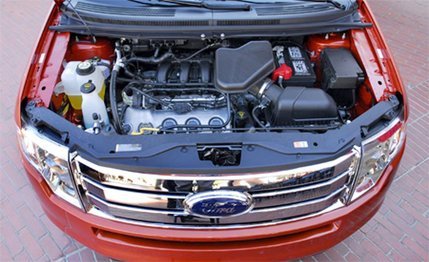 First Drive Review
First Drive Review
BMW didn't have much competition in 2000 when it dropped the sleek, fun X5 into a stodgy SUV market. Seven years later, the Audi Q7 is more car-like, the Cayenne Turbo is faster, the Mercedes GL has more functional space, and all are plush. Never seriously eclipsed were the BMW's looks or dynamic prowess, so the all-new 2007 X5 expands on its strong suits and moves to meet the other challenges with expanded cargo space and a first-ever third row of seats.
The X5 is taller than a Jeep Grand Cherokee and weighs nearly as much as a Chevy Tahoe, but BMW buyers still want a vehicle that drives like a BMW. The X5 has always had some of the sprightliest footwork of the luxo-utes, and BMW claims to have stepped it up big time with the new model. The new suspension configuration reads like a spec sheet for a proper sports car: Unequal-length control arms in front, and a multilink independent rear, with optional active damping (Electronic Damping Control) and variable rate roll stiffness (Active Roll Stabilization) on Sport Package-equipped vehicles. This layout is obviously better equipped for switchbacks than the Rubicon, but the last time we saw an X5 or Cayenne off-pavement was at a fruit stand.
An alphabet soup of technology upgrades.
The coordination of Electronic Damping Control and Active Roll Stabilization is handled by AdaptiveDrive, a system that promises superior dynamic control without any penalty in ride. The system works by processing data from numerous sensors to control body motion and magnetically-controlled damper valving. Press the Sport button on the center console and a different handling map will shore up the footwork with more aggressive valving and anti-roll bar settings. If you're going to spend this much on a vehicle, the extra $3600 for the Sport Package strikes us as a no-brainer. It also includes 19-inch wheels and tires, special trim, and paint.
FlexRay, an in-car data transmission protocol that's about twenty times faster than comparable systems, gets its world debut in the new Sport Package-equipped X5s. Developed with a large consortium of companies including DaimlerChrysler, GM, and VW, FlexRay has a bandwidth of 10 Mbit/second, or about 200 billion floating-point operations per second, enabling speedy communication of greater numbers of data points between the sensors and processors that facilitate active systems like safety, collision avoidance, powertrain management, and suspension. This means faster and more accurate response while leaving enough free bandwidth to download illicit copies of Pirates of the Caribbean 2.
As stiff as a race car.
Albert Biermann, the X5 Project Manager, was also project manager for the M3 GTR race car that handily gutted the Porsche 911 in ALMS GT racing in 2001, so when someone of his credentials is excited by a vehicle's dynamics, we listen. The X5's chassis is stiffer than the outgoing model by 15 percent, and according to Mr. Biermann, stiffer than the fully caged and seam-welded factory E30 M3 race cars he worked on in the 1980s. High-strength and ultra-high-strength steels are used liberally, and trick bits like cast aluminum strut tower tops and a triangulated strut tower brace do much for rigidity. Biermann is also proud of the stuff you'll never see, like the carrier for the instrument panel, which is a light, stiff one-piece magnesium casting.
Active Steering is an option on Sport Package X5s, but it's a system we weren't terribly impressed with in the 5-series, so we see no reason to stray from the fine standard rack and pinion.
We don't imagine brake fade being much of an issue with 13.7-inch front, and 13.6-inch rear brake rotors on the 4.8i and 13.1-inch front, 12.6-inch rear rotors in the 3.0si; the outgoing X5 stopped from 70 mph in just 164 feet. Flog your X5 at a lapping day and rest assured that the Brake Fade Compensation system can step in as needed, as can Brake Standby and Brake Drying.